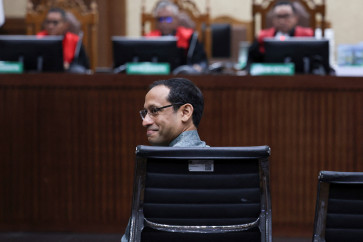Popular Reads
Top Results
Can't find what you're looking for?
View all search resultsPopular Reads
Top Results
Can't find what you're looking for?
View all search resultsMultiple ways for determining Ramadhan
As Romans built many roads leading to Rome, Muslims in Indonesia use numerous methods to determine the start of Ramadhan
Change text size
Gift Premium Articles
to Anyone
A
s Romans built many roads leading to Rome, Muslims in Indonesia use numerous methods to determine the start of Ramadhan.
Watching tidal waves and back-tracking the Hijriyah (Islamic calendar) have been used to set the start of the fasting month in addition to the standard methods of hisab (mathematical and astronomical calculations) and rukyat (lunar sightings).
The use of such unorthodox methods have led to different dates for the start of Ramadhan in addition to the government's start on Wednesday and Muhammadiyah's start on Tuesday.
While observing both hisab and rukyat, the followers of the An Nadzir sect in Gowa, South Sulawesi, added the highest tidal waves into the equation which led them to begin fasting on Monday.
However, the change from Syaban to Ramadhan occurred at between 1 p.m. and 2 p.m. local time (between noon and 1 p.m. Jakarta time) on Monday, An Nadzir leader, Ustadz Lukman A Bhakti said.
'It's impossible for us to take sahur (pre-dawn meal) at that time so we will start fasting on Tuesday,' said Lukman, adding that on Monday, the An Nadzir followers observed sunnah (non-obligatory) fasting to welcome Ramadhan.
Also starting fasting on Monday was the Samaniyah sect in Cerobong mosque, Koto Panjang sub-district, in Padang, West Sumatra. The sect decides Ramadhan 1 by calculating 15 days after the full moon in Syaban, which proceeds Ramadhan.
The Naqsabandiyah sect even started fasting on Sunday by using the hijab munjib method.
'We decide the start of Ramadan by calculating 360 days from last year's Ramadhan 1,' said Edison, the West Sumatra Naqsabandiyah secretary in Padang, on Monday.
Another sect, Syattariah has yet to decide while in the previous years it started Ramadhan one day later than the date set by the government.
Indonesia's second largest Muslim organization, Muhammadiyah, said that it uses falak (astronomy) to determine the beginning and end Ramadhan.
'We use the hisab method to calculate the existence of hilal or new moon, which marks the beginning of Ramadhan,' Muhammadiyah chairman Din Syamsudin said on Monday.
Din explained that based on the hisab method, the Muhammadiyah calculated that the conjunction of the moon and the sun happened at 2:15 p.m. on Monday. Therefore, the new moon, which marks the start of a new month, could be seen from 5:30 p.m. to 5:38 p.m. on Monday in some of Indonesia's western provinces.
'We don't estimate the new moon based on direct observation of hilal, or rukyat method, like the government. The climate in Indonesia has been so uncertain recently, resulting in cloudy skies. So, how could it be possible to see hilal clearly?' he asked.
Separately, Thomas Djamaluddin, an astronomy and astrophysics research professor with the National Institute of Aeronautics and Space (Lapan) criticized the Muhammadiyah's method, saying the method was out-of-date.
'The hilal is still very low just between 0 and 0.7 degrees above the horizon in western Indonesia,' he said. 'In central and eastern parts of Indonesia, the hilal is still below the horizon.'
Answering the criticism, Din said that he assumed the comment was made by an astronomer who supported the government's method.
'Independent astronomers would not make such comments,' he said. (tam)
' Arya Dipa contributed to the article from Bandung










